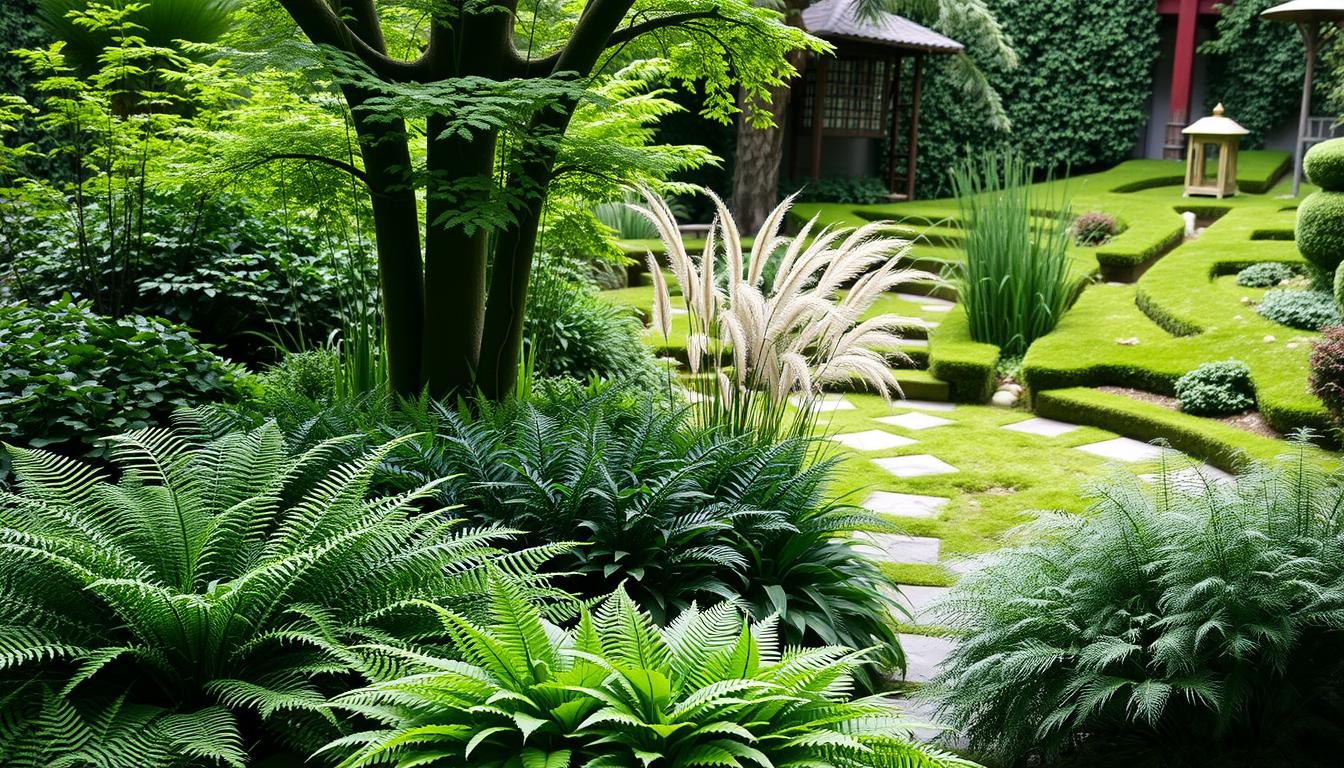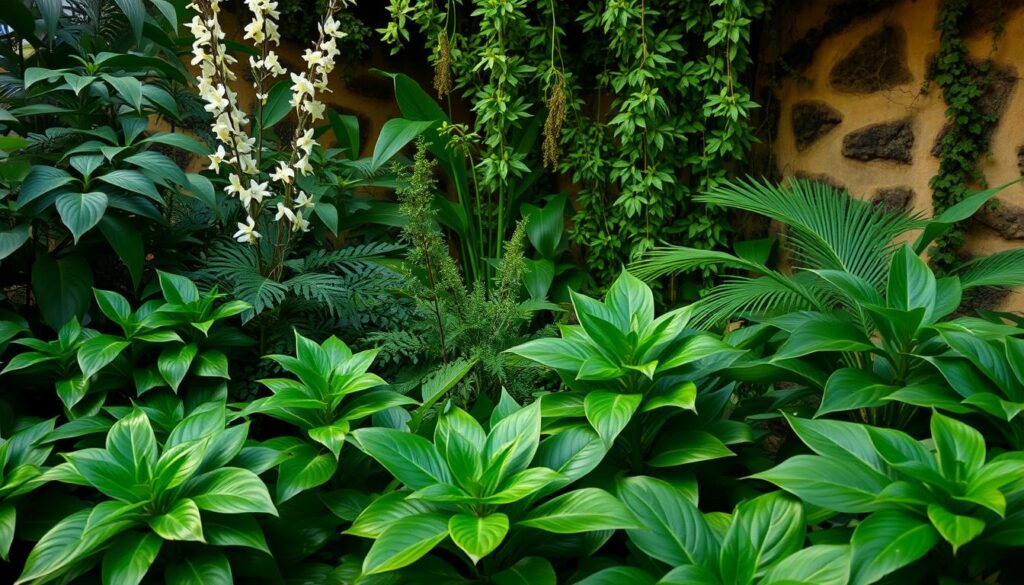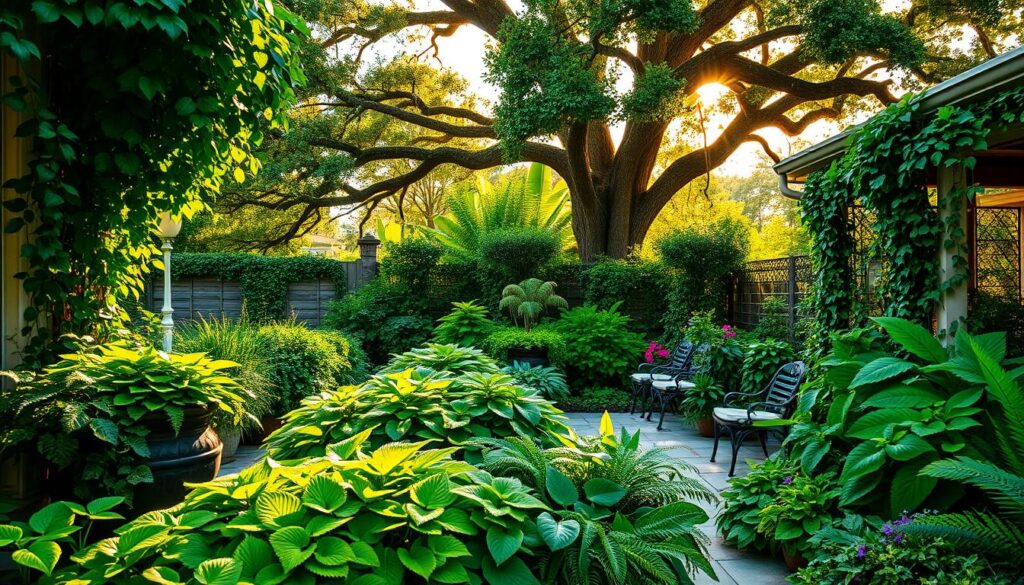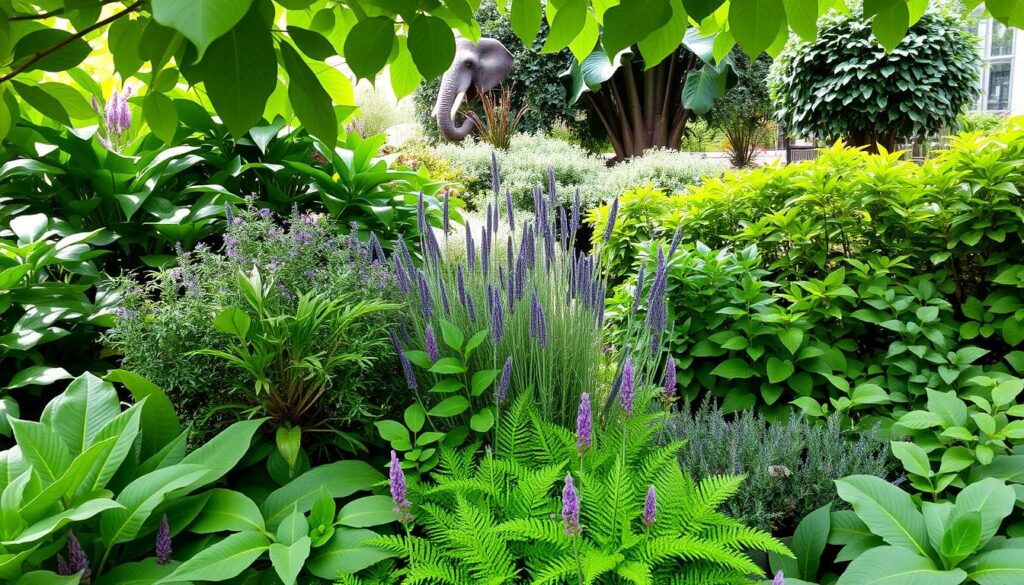
10 Shade-Loving Plants Perfect for a Cool Patio OasisCool Patio10 Shade-Loving Plants Perfect for a Cool Patio Oasis
Are you tired of a patio that’s more sunbaked than serene? Creating a cool patio oasis is easier than you think. It starts with the right plants.
Imagine sipping your morning coffee or enjoying a relaxing evening surrounded by lush greenery. This greenery thrives in the shade. Incorporating the best shade-loving plants can transform your outdoor space into a tranquil retreat.
These plants add aesthetic appeal and help keep your patio cool. This makes your patio a perfect escape from the heat. In this article, we’ll explore 10 stunning options. They can turn your patio into a lush haven.
Why Choose Shade Plants for Your Patio?
Shade plants bring many benefits to your patio. They make your outdoor space more inviting and comfortable. This is great for relaxing and having fun.
Benefits of Shade Plants
Shade plants offer many advantages. They cut down on the need for other shading and make your patio cooler. They also make your patio look better by adding variety and texture.
Also, shade plants can lower noise and improve air quality. This makes your patio even more comfortable and peaceful.
How Shade Plants Enhance Comfort
Shade plants make your patio more comfortable by cooling it down. This makes spending time outside more enjoyable. It also encourages you to relax and socialize for longer.
By picking and arranging shade garden plants wisely, you can create a beautiful patio oasis. It’s perfect for hot days or whenever you need a calm spot.
Popular Shade-Loving Perennials
For a lush and inviting patio, consider incorporating popular shade-loving perennials. These plants not only thrive in shaded conditions but also add beauty and texture to your outdoor space.
Among the most popular shade-loving perennials are Hostas and Ferns. Hostas are incredibly versatile, coming in a variety of sizes and colors that can fit any patio design. They are also relatively low-maintenance, requiring minimal care to flourish.
Hostas: Versatile and Beautiful
Hostas are a favorite among gardeners due to their adaptability and aesthetic appeal. They can be used as a border, a focal point, or even as a container plant. Their leaves come in various shades of green, gold, and variegated patterns, adding visual interest to your patio.
Ferns: Lush and Low-Maintenance
Ferns bring a lush, tropical feel to your patio, thriving in shady conditions with minimal maintenance. They are ideal for busy homeowners who want to enjoy a beautiful outdoor space without the hassle of high upkeep. Ferns also add a delicate texture to your patio, creating a soothing ambiance.
Both Hostas and Ferns are excellent choices for plants for shady areas, offering a combination of beauty, versatility, and low maintenance. By incorporating these perennials into your patio design, you can create a serene and inviting outdoor oasis.
Flowering Shade Plants to Brighten Your Space
Shade-tolerant flowering plants can make your patio look amazing. They add color and create a calm vibe. This makes your outdoor area more welcoming.
When picking shade plants, think about their growth, care needs, and how they fit with your patio design. The right plants can make your shaded area colorful and textured.
Astilbe: Vibrant Colors and Textures
Astilbe is great for shade gardens. It comes in many colors and has soft, feathery plumes. These plants love shade, making them perfect for sunny spots.
Key Features of Astilbe:
| Feature | Description | Benefits |
|---|---|---|
| Color Variety | Ranges from soft pastels to vibrant reds and purples | Adds visual interest and beauty to your patio |
| Texture | Feathery plumes provide a soft, delicate texture | Creates a romantic ambiance |
| Maintenance | Low maintenance, requiring minimal care | Ideal for busy homeowners |
Bleeding Heart: Unique and Elegant Blooms
Bleeding Heart is elegant for shaded spots. Its heart-shaped blooms hang from stems, adding sophistication. It’s a great feature for any garden.
Bleeding Heart is not only beautiful but also easy to care for. It does well in shade and needs little attention. It’s perfect for those who want elegance outdoors.

Adding Astilbe and Bleeding Heart to your patio makes it beautiful and inviting. They showcase the beauty of flowering shade plants.
Leafy Green Shade Plants for Foliage
Shade-loving plants with lush green foliage can turn your patio into a peaceful retreat. It’s perfect for relaxation and entertainment. These plants add natural beauty and create a soothing atmosphere, great for unwinding after a long day.

When picking leafy green shade plants, think about their texture, movement, and color. This will make your landscape look good. Japanese Forest Grass and Heuchera are great for adding foliage to your patio.
Japanese Forest Grass: Graceful Movement
Japanese Forest Grass is a top pick for a dynamic shade garden. Its delicate, arching foliage moves gracefully in the breeze. This adds a soothing effect to your outdoor space. It’s also easy to care for and thrives in shaded areas.
Heuchera: Colorful Leaves Year-Round
Heuchera is another great choice for shade gardens. It offers colorful leaves year-round that add visual interest to your patio. With many colors like silver, gold, and burgundy, Heuchera is versatile and attractive. It complements other shade plants well.
Adding these leafy green shade plants to your patio design makes it lush and vibrant. It’s perfect for relaxation and entertainment. Japanese Forest Grass and Heuchera are great for landscaping and enhance your patio’s look.
Fast-Growing Shade Plants for Quick Coverage
Fast-growing shade plants are great for making your outdoor space lively. They add beauty and make your area feel lush and welcoming.
When picking fast-growing shade plants, choose ones that do well in shade and grow fast. Black-Eyed Susan and Creeping Jenny are excellent choices. They are perennial shade plants that bring elegance and color to your patio.
Black-Eyed Susan: Cheerful Blooms
Black-Eyed Susan (Rudbeckia hirta) brightens up any shaded patio. Its daisy-like flowers with dark centers and bright yellow petals add color. It’s easy to care for and does well in partial shade, perfect for areas with less sunlight.

Creeping Jenny: Ground Cover with Flair
Creeping Jenny (Lysimachia nummularia ‘Aurea’) is great for ground cover. Its golden, coin-shaped leaves spread out, making a lush carpet. It looks good and helps keep weeds away, making it a smart choice for your patio garden.
Both Black-Eyed Susan and Creeping Jenny are great for adding beauty and coverage to your shaded patio. By adding these plants to your garden, you’ll create a vibrant and inviting space to enjoy for years.
Shade-Specific Herbs for Your Patio Garden
Herbs that grow well in shade can make your patio garden more beautiful and useful. Adding shade-specific herbs to your outdoor space boosts its look. It also gives you fresh flavors for cooking.
Mint is a top pick for shaded spots. It has a refreshing smell and taste, perfect for many dishes and drinks. Mint is easy to care for, making it ideal for those with little time to garden.
Mint: Refreshing Aroma and Flavor
Mint cools you down and is great in teas, cocktails, and sweets. It also adds freshness to salads and savory meals. Just remember to keep mint in check to stop it from spreading.
Chives: Easy and Edible Elegance
Chives are perfect for shade gardens too. They bring a light onion taste to food and are simple to grow. Chives need little care and can be picked all season long.
| Herb | Shade Tolerance | Culinary Use |
|---|---|---|
| Mint | Partial to Full Shade | Teas, Cocktails, Desserts |
| Chives | Partial Shade | Salads, Savory Dishes, Garnishes |

Selecting the Right Container for Shade Plants
Choosing the right container for your shade plants is key for their health and look. The container holds the soil and roots and adds to your patio’s beauty.
When picking a container, several things matter. The material, size, and how well it drains are all important. They can greatly affect your shade-loving plants.
Material Considerations
The container’s material can change the soil’s temperature and moisture. Terracotta pots are good because they let air in, preventing soggy soil. Plastic and metal containers are light and strong, respectively.
| Material | Breathability | Durability |
|---|---|---|
| Terracotta | High | Medium |
| Plastic | Low | High |
| Metal | Low | High |
Size and Drainage Tips
The container’s size should match the plant’s root system. A too-small container can limit growth, while a too-large one can make the soil too wet. It’s also important to have good drainage to avoid root rot. Make sure your container has enough holes for water to drain.
By thinking about the material, size, and drainage of your container, you can make a great home for your shade plants.
Maintenance Tips for Shade Plants
Caring for shade plants means paying attention to their watering and fertilization needs. It’s not just about placing them in a shaded spot. You need to think carefully about how to care for them.
Watering Needs in Shaded Areas
Shade plants need different amounts of water than those in sunny spots. The shade can make water evaporate slower, which might lead to too much water if not watched. It’s key to check the soil moisture often.
Tips for Watering Shade Plants:
- Check soil moisture by inserting a finger into the soil up to the knuckle.
- Water plants in the morning to minimize fungal growth.
- Avoid getting water on the leaves to prevent fungal diseases.
| Plant Type | Watering Frequency | Soil Preference |
|---|---|---|
| Hostas | Regular, but avoid overwatering | Moist, well-draining soil |
| Ferns | Consistent moisture | High humidity, well-draining acidic soil |
| Astilbe | Regular watering, but more during dry spells | Moist soil rich in organic matter |
Fertilization Practices
Fertilizing your shade plants is key to their health. But, the type and how often you fertilize can change based on the plant.
General Fertilization Tips:
- Use a balanced, slow-release fertilizer for steady nutrient supply.
- Fertilize during the growing season for best results.
- Some plants might need more frequent fertilizing, so check their needs.
By following these tips, you can keep your shade plants healthy. They will continue to make your patio look beautiful.
Seasonal Care for Shade Plants
To keep your shade tolerant plants healthy all year, knowing their seasonal needs is key. Changes in seasons can greatly affect your plants’ health and look. Adjusting your care routine is very important.
Preparing for Winter: What to Do
As winter comes, it’s crucial to get your shade plants for landscaping ready for the cold. Start by cleaning up debris around your plants to stop rot and disease. Mulching around the base of your plants helps keep moisture in and keeps the soil temperature right.
If your plants are delicate, think about using a frost cloth. Or, bring potted plants to a place that’s protected from the cold.
Spring Awakening: Reviving Your Plants
When spring arrives, it’s time to wake up your shade plants after a cold winter. Start by removing any dead or damaged leaves to make room for new growth. Check your plants for winter damage and prune them if needed.
Fertilizing your shade plants in the spring gives them the nutrients they need to grow well during the growing season.
By following these seasonal care tips, your shade plants for landscaping will keep your patio beautiful all year.
Creating a Balanced Patio Oasis with Shade Plants
A well-designed patio with shade plants is a peaceful spot for relaxation and fun. To make it great, think about adding layers and heights. This will make your outdoor space more interesting to look at.
Layered Design for Visual Appeal
Using Perennial Shade Plants of different heights and textures can make a layered look. For instance, tall plants like ferns can be mixed with shorter ones like Creeping Jenny. This adds depth to your patio.
Enhancing with Hardscaping
Adding stone or wood elements can also make your patio look better. Full Shade Plants like Hostas go well with wooden planters or stone paths. This creates a nice balance.
By mixing these design ideas, you can make a beautiful patio oasis. It will be a great place for both relaxing and having fun. This balanced design will highlight the beauty of shade plants.
Leave a Reply